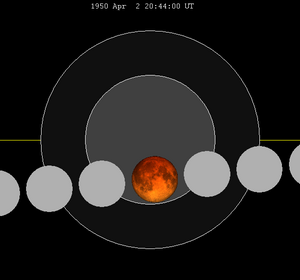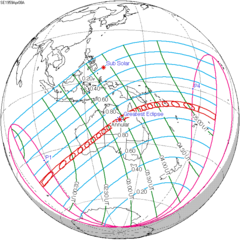| Total eclipse | |||||||||||||||||
 The Moon's hourly motion shown right to left The Moon's hourly motion shown right to left | |||||||||||||||||
| Date | April 2, 1950 | ||||||||||||||||
|---|---|---|---|---|---|---|---|---|---|---|---|---|---|---|---|---|---|
| Gamma | −0.4599 | ||||||||||||||||
| Magnitude | 1.0329 | ||||||||||||||||
| Saros cycle | 131 (30 of 72) | ||||||||||||||||
| Totality | 26 minutes, 54 seconds | ||||||||||||||||
| Partiality | 189 minutes, 35 seconds | ||||||||||||||||
| Penumbral | 306 minutes, 32 seconds | ||||||||||||||||
| |||||||||||||||||
| ← October 1949September 1950 → | |||||||||||||||||
A total lunar eclipse occurred at the Moon’s descending node of orbit on Sunday, April 2, 1950, with an umbral magnitude of 1.0329. A lunar eclipse occurs when the Moon moves into the Earth's shadow, causing the Moon to be darkened. A total lunar eclipse occurs when the Moon's near side entirely passes into the Earth's umbral shadow. Unlike a solar eclipse, which can only be viewed from a relatively small area of the world, a lunar eclipse may be viewed from anywhere on the night side of Earth. A total lunar eclipse can last up to nearly two hours, while a total solar eclipse lasts only a few minutes at any given place, because the Moon's shadow is smaller. Occurring only about 23 hours before perigee (on April 3, 1950, at 20:00 UTC), the Moon's apparent diameter was larger.
This lunar eclipse was the third of a tetrad, with four total lunar eclipses in series, the others being on April 13, 1949; October 7, 1949; and September 26, 1950.
This was the first total lunar eclipse of Lunar Saros 131.
Visibility
The eclipse was completely visible over much of Africa, Europe, and the western half of Asia, seen rising over South America and setting over east and northeast Asia and Australia.
 
|
Eclipse details
Shown below is a table displaying details about this particular solar eclipse. It describes various parameters pertaining to this eclipse.
| Parameter | Value |
|---|---|
| Penumbral Magnitude | 1.99513 |
| Umbral Magnitude | 1.03288 |
| Gamma | −0.45987 |
| Sun Right Ascension | 00h46m07.6s |
| Sun Declination | +04°57'20.0" |
| Sun Semi-Diameter | 15'59.8" |
| Sun Equatorial Horizontal Parallax | 08.8" |
| Moon Right Ascension | 12h45m13.6s |
| Moon Declination | -05°21'58.0" |
| Moon Semi-Diameter | 16'37.5" |
| Moon Equatorial Horizontal Parallax | 1°01'00.8" |
| ΔT | 29.2 s |
Eclipse season
See also: Eclipse cycleThis eclipse is part of an eclipse season, a period, roughly every six months, when eclipses occur. Only two (or occasionally three) eclipse seasons occur each year, and each season lasts about 35 days and repeats just short of six months (173 days) later; thus two full eclipse seasons always occur each year. Either two or three eclipses happen each eclipse season. In the sequence below, each eclipse is separated by a fortnight.
| March 18 Ascending node (new moon) |
April 2 Descending node (full moon) |
|---|---|
 |

|
| Annular solar eclipse Solar Saros 119 |
Total lunar eclipse Lunar Saros 131 |
Related eclipses
Eclipses in 1950
- An annular solar eclipse on March 18.
- A total lunar eclipse on April 2.
- A total solar eclipse on September 12.
- A total lunar eclipse on September 26.
Metonic
- Preceded by: Lunar eclipse of June 14, 1946
- Followed by: Lunar eclipse of January 19, 1954
Tzolkinex
- Preceded by: Lunar eclipse of February 20, 1943
- Followed by: Lunar eclipse of May 13, 1957
Half-Saros
- Preceded by: Solar eclipse of March 27, 1941
- Followed by: Solar eclipse of April 8, 1959
Tritos
- Preceded by: Lunar eclipse of May 3, 1939
- Followed by: Lunar eclipse of March 2, 1961
Lunar Saros 131
- Preceded by: Lunar eclipse of March 22, 1932
- Followed by: Lunar eclipse of April 13, 1968
Inex
- Preceded by: Lunar eclipse of April 22, 1921
- Followed by: Lunar eclipse of March 13, 1979
Triad
- Preceded by: Lunar eclipse of June 1, 1863
- Followed by: Lunar eclipse of January 31, 2037
Lunar eclipses of 1948–1951
| Descending node | Ascending node | |||||
|---|---|---|---|---|---|---|
| Saros | Date viewing |
Type chart |
Saros | Date viewing |
Type chart | |
| 111 | 1948 Apr 23
|
Partial
|
116 | 1948 Oct 18
|
Penumbral
| |
| 121 | 1949 Apr 13
|
Total
|
126 | 1949 Oct 07
|
Total
| |
| 131 | 1950 Apr 02
|
Total
|
136 | 1950 Sep 26
|
Total
| |
| 141 | 1951 Mar 23
|
Penumbral
|
146 | 1951 Sep 15
|
Penumbral
| |
Saros 131
Lunar Saros series 131, has 72 lunar eclipses. Solar Saros 138 interleaves with this lunar saros with an event occurring every 9 years 5 days alternating between each saros series.
This eclipse series began in AD 1427 with a partial eclipse at the southern edge of the Earth's shadow when the Moon was close to its descending node. Each successive Saros cycle, the Moon's orbital path is shifted northward with respect to the Earth's shadow, with the first total eclipse occurring in 1950. For the following 252 years, total eclipses occur, with the central eclipse being predicted to occur in 2078. The first partial eclipse after this is predicted to occur in the year 2220, and the final partial eclipse of the series will occur in 2707. The total lifetime of the lunar Saros series 131 is 1280 years. Solar Saros 138 interleaves with this lunar saros with an event occurring every 9 years 5 days alternating between each saros series.
Because of the ⅓ fraction of days in a Saros cycle, the visibility of each eclipse will differ for an observer at a given fixed locale. For the lunar Saros series 131, the first total eclipse of 1950 had its best visibility for viewers in Eastern Europe and the Middle East because mid-eclipse was at 20:44 UT. The following eclipse in the series occurred approximately 8 hours later in the day with mid-eclipse at 4:47 UT, and was best seen from North America and South America. The third total eclipse occurred approximately 8 hours later in the day than the second eclipse with mid-eclipse at 12:43 UT, and had its best visibility for viewers in the Western Pacific, East Asia, Australia and New Zealand. This cycle of visibility repeats from the initiation to termination of the series, with minor variations. Solar Saros 138 interleaves with this lunar saros with an event occurring every 9 years 5 days alternating between each saros series.
Lunar Saros series 131, repeating every 18 years and 11 days, has a total of 72 lunar eclipse events including 57 umbral lunar eclipses (42 partial lunar eclipses and 15 total lunar eclipses). Solar Saros 138 interleaves with this lunar saros with an event occurring every 9 years 5 days alternating between each saros series.
| Greatest | First | |||
|---|---|---|---|---|
 The greatest eclipse of the series will occur on 2094 Jun 28, lasting 102 minutes. |
Penumbral | Partial | Total | Central |
| 1427 May 10 | 1553 July 25 | 1950 Apr 2 | 2022 May 16 | |
| Last | ||||
| Central | Total | Partial | Penumbral | |
| 2148 Jul 31 | 2202 Sep 3 | 2563 Apr 9 | 2707 Jul 7 | |
| 1914 Mar 12 | 1932 Mar 22 | 1950 Apr 2 | |||

|

|

|

|

|

|
| 1968 Apr 13 | 1986 Apr 24 | 2004 May 4 | |||

|

|

|

|

|

|
| 2022 May 16 | 2040 May 26 | 2058 Jun 6 | |||

|

|

|

|

|

|
| 2076 Jun 17 | 2094 Jun 28 | ||||

|

|

|

| ||
The next occurrence was on April 13, 1968. The previous occurrence was March 22, 1932.
Half-Saros cycle
A lunar eclipse will be preceded and followed by solar eclipses by 9 years and 5.5 days (a half saros). This lunar eclipse is related to two total solar eclipses of Solar Saros 138.
| March 27, 1941 | April 8, 1959 |
|---|---|

|

|
See also
Notes
- "April 2–3, 1950 Total Lunar Eclipse (Blood Moon)". timeanddate. Retrieved 21 December 2024.
- "Moon Distances for London, United Kingdom, England". timeanddate. Retrieved 21 December 2024.
- "Total Lunar Eclipse of 1950 Apr 02" (PDF). NASA. Retrieved 21 December 2024.
- "Total Lunar Eclipse of 1950 Apr 02". EclipseWise.com. Retrieved 21 December 2024.
- Listing of Eclipses of cycle 131
- Mathematical Astronomy Morsels, Jean Meeus, p.110, Chapter 18, The half-saros
External links
- 1950 Apr 02 chart Eclipse Predictions by Fred Espenak, NASA/GSFC
This lunar eclipse-related article is a stub. You can help Misplaced Pages by expanding it. |


